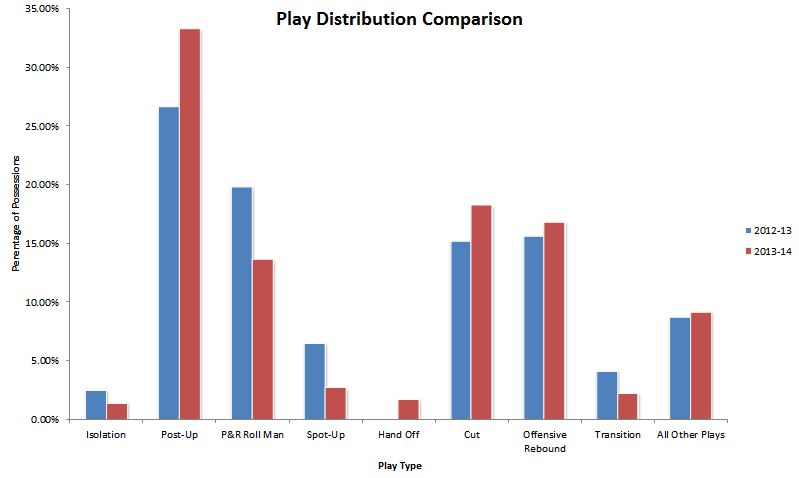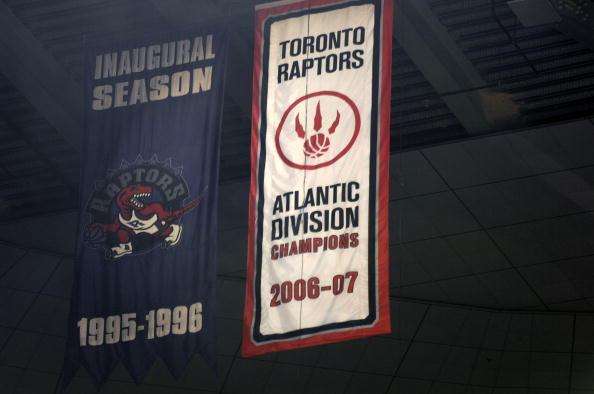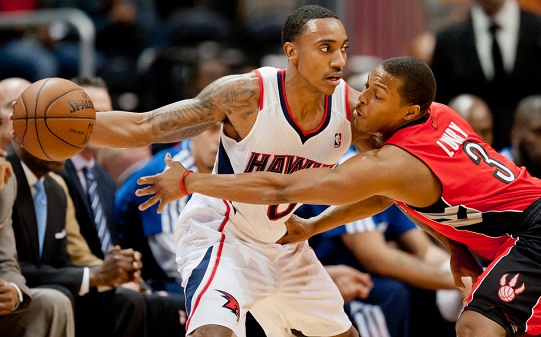Is he Hakeem yet? (hint: nope)
Last off-season, when I was naught more than a no-name blogger (still am) typing away in the dark corners of the internet (still am), I submitted an article concerning Jonas Valanciunas for publication here on Raptors Republic. Luckily, Blake and Zarar reviewed the column, and because they were starved for content in the summer my analysis was immaculate, they decided to publish it here on RR.
Looking back, I might have been a little generous with my praise. Like many others, I pinned the entirety of my hopes onto the shoulders of the 21 year old. I lavished Jonas with unearned compliments, using words like “stellar” and “excellent” to describe his arsenal of move on offense. Since I am older and wiser — and therefore more cynical — I decided to give an update on Jonas Valanciunas’ offensive development.
Statistical Breakdown
First, let’s start by reviewing his boxscore contributions. Most of Jonas’ raw offensive per-game averages have increased — he’s scoring more, he’s shooting more free-throws and he’s grabbing more offensive rebounds. The rub is that his uptick in raw production have largely come as a result of increased minutes, as his per-36 minute average has stayed largely unchanged (13.7 this season. 13.5 last season).
If we dive into his advanced metrics, we find that Jonas’ offensive rating (points scored per 100 possessions) has dropped from 113 to 106. As a reference, that delta marks the same difference as Stephen Curry and Ramon Sessions’ career averages. The steep drop in offensive rating is largely due to a dip in his shooting percentages, as his near-league leading true-shooting percentage of 61.9% from last season has now regressed, and his current mark of 54.7% places him much closer to league average.
Digging deeper, we find that Jonas is using a greater share of the Raptors’ possessions while he’s on the court this season, and his +/- effect on the team has jumped from +0.3 points per 100 possessions, to +5.3 points per 100 possessions.
The most interesting difference is the shift in Jonas’ possession types. He’s being used far more in the post, and he’s shied away from the pick-and-roll.
All in all, there’s not too much that can be gleamed from the numbers alone. His scoring efficiency and general offensive efficiency is down, but he’s also grabbing more offensive rebounds, he’s shooting more free-throws, his net effect on the team is up, and he’s chowing a bigger slice of the pie on offense. So has he improved?
Play Breakdown
A more worthy exercise than number crunching is looking at the actual changes in his game with video evidence as our guide. I will partition the breakdown into two parts — detailing his capabilities in the pick-and-roll, and in the post.
Pick-and-Roll
Over his first two seasons in the NBA, Jonas has proven to be a decent pick-and-roll big man. Last season, given Jose Calderon’s presence on the team, the pick-and-roll accounted for ~20% of Jonas’ offensive possessions, and he scored a ridiculous 1.23 points per play (PPP) which ranked 16th in the NBA. This season, his unsustainably high points per play average has dropped back down to a respectable 0.99 (63rd in NBA).
Interestingly enough, the drop in point per play averages between years one and two is almost entirely attributable to Jonas’ inability to sink a jumper. Of his 67 possessions in the PnR this season, he has launched 28 jumpers and only sunk 8. Take out those 28 possessions and voila, his PPP is back at 1.23, which means that when he rolls to the rim, he scores at a near league-leading rate, but when he pops, he’s scores at a Pops Mensah-Bonsu-like rate.
Last season, Jonas shot a respectable 41.1% on shots from the midrange. That figure has dipped to 31.5% this season, which in turn has given rise to this discrepancy in the shot chart:
 Jonas demonstrates good awareness in the pick-and-roll. His screen-setting still leaves much to be desired — Lowry often has to ask Jonas to reposition himself — but he presents a large target, and he is adept at finding the temporary lulls in opposing defenses, especially when defenders opt to trap the ball-handler. He usually keeps the ball high which helps him limit his turnovers (only 6.1% of his possessions in the PnR result in a turnover).
Jonas demonstrates good awareness in the pick-and-roll. His screen-setting still leaves much to be desired — Lowry often has to ask Jonas to reposition himself — but he presents a large target, and he is adept at finding the temporary lulls in opposing defenses, especially when defenders opt to trap the ball-handler. He usually keeps the ball high which helps him limit his turnovers (only 6.1% of his possessions in the PnR result in a turnover).
Valanciunas struggles when he receives the ball in the high-post area after setting a ball screen. He’s always open for the jumpshot because defenders are far more concerned with stopping the ball-handler, but as mentioned earlier, Jonas simply cannot shoot from outside the paint. This leaves him with three options — shoot (and miss), go into his post-move, or kicking it out for a reset. Oftentimes, Jonas is indecisive and awkward with the ball, which stalls the offense. His only decent move in this scenario is to pump-fake the recovering help-defender, and if he gets them up into the air, this happens:
Post-Up Situations
Jonas’ uptick in usage this season is almost entirely attributable to his increased presence in the post. Last season, post-ups represented 27% of Jonas’ possessions as compared to 33% this season. Dwane Casey likes to establish Jonas in the post at the beginning of games, and Lowry makes a concerted effort to force-feed him the ball. He’s a decent scorer in the post, netting a robust 0.88 PPP on post-ups, which currently ranks 42nd in the NBA.
Valanciunas likes to catch the ball on the left side of the floor, but delivering him the ball is somewhat of a challenge. Despite his size, he struggles with holding his position and is completely neutralized when defenders opt to front him.
When he catches the ball, his first move is always to face up and shot-fake. His shot is flat-footed, so his fake is an easy sell, but he book on Jonas is out — he can’t shoot from midrange — so disciplined defenders just stay down. If and when his shot-fake doesn’t work, Jonas turns around and backs down his defender. He usually takes three or four dribbles before collecting the ball and galloping into the middle of the lane for a sweeping hook shot.
His primary move is effective for two reasons. One, he has good touch around the basket and his hook is fairly soft, which gives the shot a decent chance of dropping even if it catches rim. Two, Jonas leans into his defender, keeping them ground-bound, which makes his shot hard to block (unless you’re Anthony Davis).
Defenders have largely clued into Jonas’ primary move, and they’ve started to lean on his left side in an effort to take away the middle and shade him towards the baseline. Jonas likes to counter this by spinning off the pressure, and dropping a jump-hook over the defender, something that he didn’t have in his arsenal last season.
The biggest hole in Jonas’ post-game is turnovers. This season, he has turned the ball over on ~15% of his post-up attempts and he struggles mightily against double-teams. He is usually able to reset the ball to a perimeter player, but he has a tendency to cradle the ball and huddle-up when approached by the second defender. By keeping the ball low, he neutralizes his height advantage, and makes it easier for defenders to strip away the ball.
Parting Shots
All in all, despite some regression on his jumpshot, I’d contend that Jonas has slightly improved on offense. He has taken on a larger role, especially in the post — he currently ranks 21st in the NBA in close-touches per game — while holding his rate of production constant. Opposing defenses have made adjustments — conceding the jumper, for example — and Jonas has developed some counters. He has yet to take the proverbial “leap”, but the same tools and skillset that wooed us in the first place are still there.
The axillary portions of the game are still largely lost on Jonas, who sometimes looks out of sync with the fast pace of the NBA. He still needs his teammates to direct his movements on offense, and he has a tendency to be indecisive with the ball. Hopefully, these finer points of the game will be smoothed out with added experience.
The next step for Jonas should be to improve his jumpshot. If he is able to consistently knock down ~40% of his jumpers, defenders will be forced to stick closer to him when he steps out. This should benefit both Jonas — who has the quickness to beat defenders to his spot — and his teammates, who should see cutting lanes open up as a result of better floor-spacing. If the jumper improves, Jonas should have no problems with becoming the third option on offense.
Finally, if I may, I’d like to preach patience on the part of Jonas’ development. Growing pains are called pains for a reason — they’re frustrating, and unpredictable. On some nights — games against the Jazz and the Nets come to mind — Jonas will flash all the signs of becoming a consistent force on offense, and on other nights, searing images of Gustavo Ayon shutting him down will lash against our eyes. The non-linearity of the process will likely persist, and it would be wise on our parts to keep the big picture in mind. Jonas is on a journey, and as John Steinbeck once said:
“A journey is like marriage. The certain way to be wrong is to think you control it.”
Or, in modern-speak: #LetJonasBeJonas




